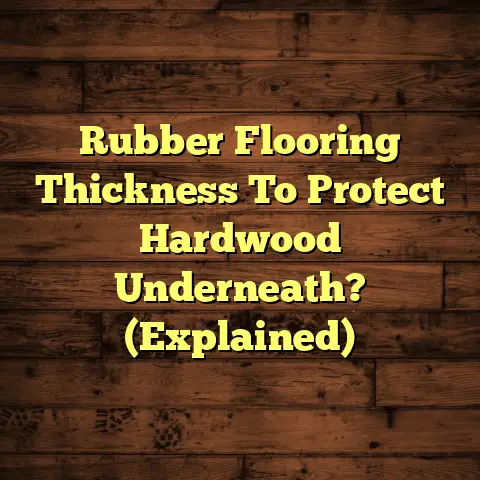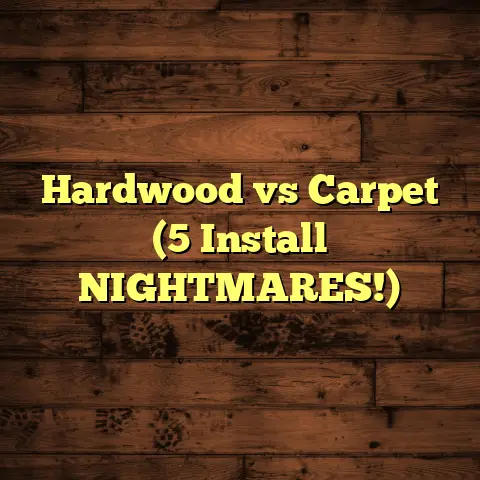Repair Vinyl Truck Floors: Easy? (6 Budget Fixes!)
I’m a flooring contractor, and over the years, I’ve seen it all when it comes to truck floors.
Especially those of you who, like me, consider your furry friends part of the family.
I get it. Your truck is your workhorse, your adventure mobile, and sometimes, your pet’s personal playground. But let’s face it.
Our beloved pets, with their enthusiastic paws and occasional “accidents,” can really put our vinyl truck floors to the test.
That’s why I wanted to share some of my go-to, budget-friendly fixes for keeping your vinyl truck floors looking great and, more importantly, safe for your four-legged companions.
We’re talking practical, cost-effective solutions that won’t break the bank or expose your pets to harmful chemicals.
Think of this as your friendly guide to DIY vinyl floor repair, tailored specifically for the challenges that come with sharing your truck with pets.
So, let’s dive in and get those floors looking their best!
Section 1: Understanding Vinyl Truck Floors
Before we start patching and sealing, let’s get a handle on what we’re working with.
Composition and Benefits
What exactly is vinyl flooring?
Well, it’s a synthetic material made primarily from polyvinyl chloride (PVC). This gives it some awesome characteristics like great durability, water resistance, and, thankfully, it’s super easy to clean.
I’ve found that these qualities make it a popular choice for trucks, where spills and messes are practically inevitable.
Vinyl flooring comes in different forms, like sheets, tiles, and planks. Each has its own pros and cons, but they all share that core benefit of being tough and easy to maintain.
Common Issues
Now, even though vinyl is durable, it’s not indestructible.
Over time, you might start seeing scratches, dents, fading from the sun, or even tears.
I’ve seen truck beds that look like they’ve been through a war zone, all thanks to heavy cargo, tools, and, yes, even pets!
These issues not only make your truck look a little rough around the edges, but they can also compromise the floor’s integrity and make it harder to clean.
Pet Considerations
This is where things get personal for us pet owners.
Our furry friends bring so much joy, but they also bring unique challenges to floor maintenance.
Think about it:
-
Claws: Those adorable little claws can wreak havoc on vinyl, leaving scratches that are unsightly and can trap dirt.
-
Accidents: Let’s be honest, accidents happen. And pet urine can be particularly damaging if it’s not cleaned up quickly.
According to the American Kennel Club, dog urine is alkaline and can stain or damage certain flooring materials if left untreated.
-
Shedding: All that fur can get embedded in the floor, making it a pain to clean.
-
Slip Resistance: Older pets, or those with joint issues, can struggle on slippery surfaces. It’s important to have a floor that provides good traction.
And, of course, we always have to think about safety.
We need to make sure that any cleaning products, adhesives, or repair materials we use are non-toxic and won’t harm our pets.
That’s why I always recommend looking for products specifically labeled as “pet-friendly.”
Section 2: Budget Fix #1 – Vinyl Floor Patches
Alright, let’s get our hands dirty!
One of the easiest and most affordable ways to fix damaged vinyl is by using vinyl floor patches.
I’ve used this method countless times, and it’s surprisingly effective.
Materials Needed
Before you start, gather these materials:
-
Vinyl Patches: You can buy these at most hardware stores. Try to find patches that closely match the color and pattern of your existing floor.
-
Utility Knife or Scissors: For cutting the patches to size.
-
Straight Edge or Ruler: To ensure clean, straight cuts.
-
Adhesive: A good quality vinyl flooring adhesive.
-
Trowel or Spreader: For applying the adhesive.
-
Seam Roller: To ensure the patch adheres firmly to the floor.
-
Cleaning Supplies: To clean the damaged area.
Step-by-Step Guide
-
Identify the Damaged Area: Carefully examine the floor and mark the areas that need patching.
-
Clean the Area: Thoroughly clean the damaged area with soap and water. Make sure it’s dry before proceeding.
-
Cut the Patch to Size: Place the vinyl patch over the damaged area and trace around it. Then, use your utility knife or scissors to cut the patch to the exact size and shape of the damaged area.
Pro Tip: I always recommend cutting the patch slightly larger than the damaged area. You can always trim it down later for a perfect fit.
-
Apply Adhesive: Using your trowel or spreader, apply a thin, even layer of adhesive to the back of the vinyl patch.
-
Position the Patch: Carefully position the patch over the damaged area and press it firmly into place.
-
Roll the Seam: Use your seam roller to roll over the patch, applying even pressure. This will ensure that the patch adheres properly to the floor and eliminates any air pockets.
-
Clean Up Excess Adhesive: Wipe away any excess adhesive with a damp cloth.
-
Allow to Dry: Let the adhesive dry completely according to the manufacturer’s instructions.
Pet-Friendly Tip
When choosing an adhesive, look for one that’s labeled as “low-VOC” or “non-toxic.”
VOCs (volatile organic compounds) are chemicals that can be harmful to both humans and pets.
I always opt for a water-based adhesive, as these tend to have lower VOC levels.
Section 3: Budget Fix #2 – Using a Vinyl Floor Repair Kit
If you’re not comfortable piecing together your own repair supplies, a vinyl floor repair kit might be the way to go.
Overview of Repair Kits
These kits typically come with everything you need to fix minor damage, including:
-
Color-Matching Fillers: To match the color of your existing floor.
-
Applicator Tools: For applying the fillers.
-
Curing Light or Heat Tool: To harden the filler.
-
Instructions: A step-by-step guide on how to use the kit.
I’ve found that these kits can be especially useful for repairing small dents, gouges, and scratches.
How to Use a Repair Kit
The exact steps will vary depending on the kit you choose, but here’s a general overview:
-
Clean the Damaged Area: As with patching, start by thoroughly cleaning the damaged area.
-
Apply the Filler: Use the applicator tool to apply the color-matching filler to the damaged area.
-
Smooth the Filler: Use the tool to smooth the filler and blend it with the surrounding floor.
-
Cure the Filler: Use the curing light or heat tool to harden the filler. Follow the instructions carefully to avoid damaging the floor.
-
Clean Up: Wipe away any excess filler with a damp cloth.
Pet Safety
Again, pay close attention to the ingredients in the repair kit.
Look for kits that are low in VOCs and free of harmful chemicals.
I also recommend ventilating the area well while you’re working and keeping your pets away until the filler is completely cured.
Section 4: Budget Fix #3 – Heat Gun for Minor Dents
This might sound a little crazy, but a heat gun can actually be used to fix minor dents in vinyl flooring.
I’ve used this trick on numerous occasions, and it’s surprisingly effective.
Understanding the Technique
The idea is that the heat softens the vinyl, allowing it to return to its original shape.
However, it’s important to use this technique with caution, as too much heat can damage the floor.
Step-by-Step Process
-
Clean the Dented Area: As always, start by cleaning the dented area.
-
Set the Heat Gun to Low: It’s crucial to start with a low heat setting to avoid damaging the floor.
-
Apply Heat: Hold the heat gun a few inches away from the dented area and move it back and forth in a sweeping motion.
-
Check for Improvement: As you apply heat, keep an eye on the dent. You should start to see it slowly disappear.
-
Cool the Area: Once the dent is gone, remove the heat gun and allow the area to cool completely.
Pro Tip: I often use a damp cloth to cool the area more quickly.
Precautions for Pets
Heat guns can get extremely hot, so it’s essential to keep your pets away from the work area.
I also recommend ventilating the area well, as the heat can release fumes from the vinyl.
Section 5: Budget Fix #4 – Vinyl Floor Sealer
Okay, so we’ve talked about fixing existing damage. But what about preventing future damage?
That’s where vinyl floor sealer comes in.
Purpose of Sealers
A good quality vinyl floor sealer can help protect your floor from scratches, stains, and other types of damage.
It also makes the floor easier to clean, which is a huge bonus for pet owners.
I’ve found that sealers can extend the life of your vinyl floor and keep it looking its best for years to come.
Application Process
-
Clean the Floor: Before applying the sealer, thoroughly clean the floor.
-
Apply the Sealer: Use a mop or applicator pad to apply a thin, even layer of sealer to the floor.
-
Allow to Dry: Let the sealer dry completely according to the manufacturer’s instructions.
-
Apply a Second Coat (Optional): For extra protection, you can apply a second coat of sealer.
Choosing Pet-Friendly Products
As always, look for sealers that are explicitly labeled as “pet-safe.”
I recommend choosing a water-based sealer with low VOC levels.
Section 6: Budget Fix #5 – Recoloring Scratches
Sometimes, even with the best care, scratches are inevitable. But don’t worry, you don’t have to live with them!
Using Markers or Paint
You can use vinyl markers or paint to cover up scratches and imperfections.
I’ve used this technique to restore countless floors, and it’s amazing how much of a difference it can make.
Application Techniques
-
Clean the Scratch: Start by cleaning the scratch with a damp cloth.
-
Choose a Matching Color: Find a vinyl marker or paint that closely matches the color of your existing floor.
-
Apply the Color: Carefully apply the color to the scratch, using a fine-tipped brush or the marker tip.
-
Blend the Color: Use a soft cloth to blend the color with the surrounding floor.
-
Allow to Dry: Let the color dry completely.
Safety Note for Pets
Again, choose non-toxic coloring products that are safe for pets.
Section 7: Budget Fix #6 – Rugs and Mats
Okay, let’s talk about the simplest and most effective way to protect your vinyl truck floor: rugs and mats!
Protective Solutions
Rugs and mats can provide a barrier between your floor and your pets’ claws, spills, and accidents.
I always recommend using rugs and mats in high-traffic areas, such as near the entrance of the truck or in areas where your pets like to hang out.
Choosing the Right Rugs
When choosing rugs and mats for your truck, look for ones that are:
-
Slip-Resistant: To prevent accidents.
-
Easy to Clean: Look for rugs that are machine-washable or easy to wipe down.
-
Durable: Choose rugs that can withstand the wear and tear of daily use.
Maintaining a Pet-Friendly Environment
The right rugs can also create a cozy and safe space for your pets in the truck.
I recommend choosing rugs that are soft and comfortable for your pets to lie on.
Conclusion
So, there you have it: six budget-friendly fixes for repairing and protecting your vinyl truck floors.
I know that dealing with pet-related messes and damage can be frustrating, but with a little bit of effort and the right tools, you can keep your truck floors looking great and safe for your furry companions.
Remember, regular maintenance is key to prolonging the life of your vinyl floors.
So, take action with the knowledge you’ve gained today and keep your truck floors looking their best! Your pets (and your wallet) will thank you for it.





